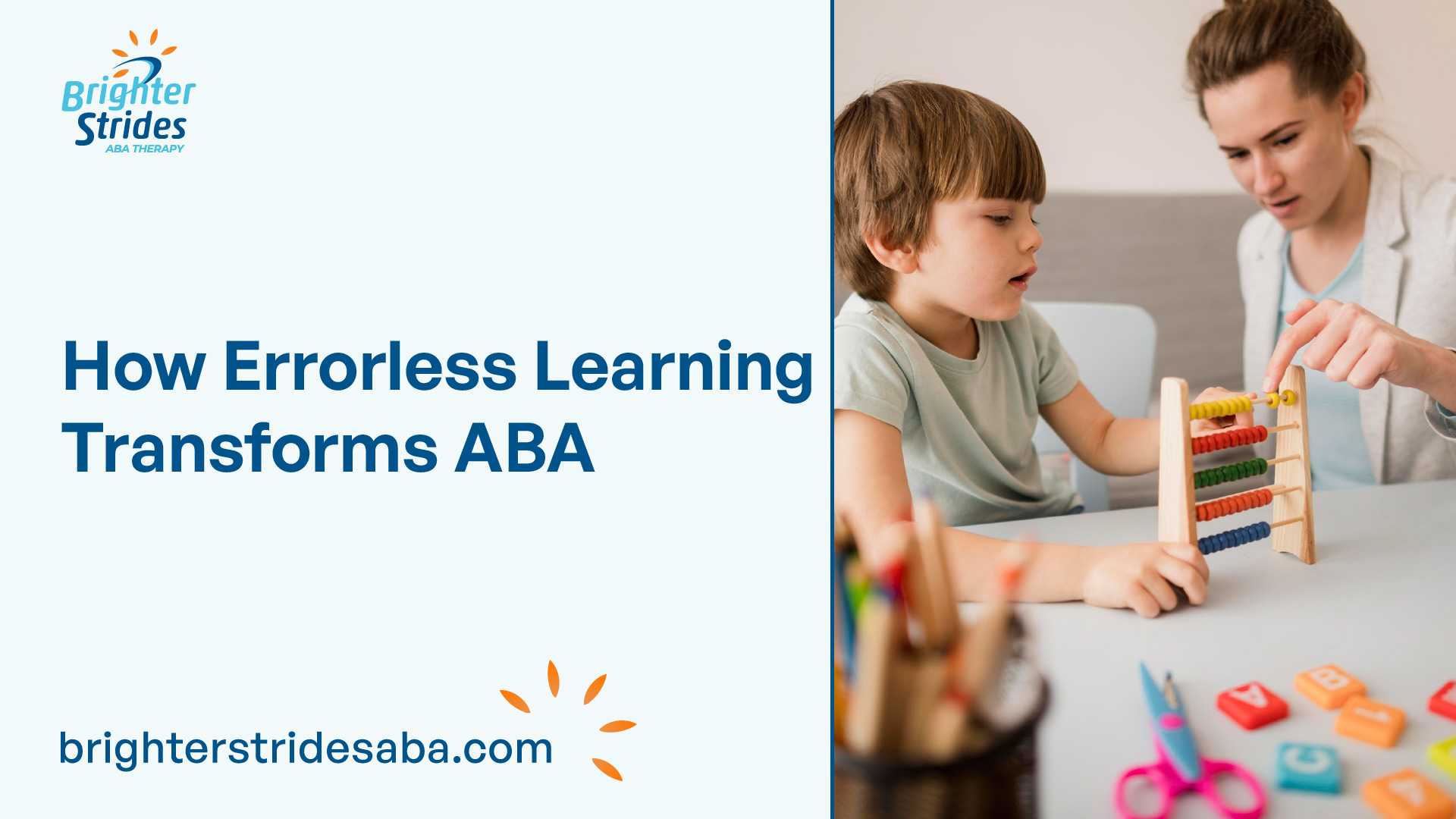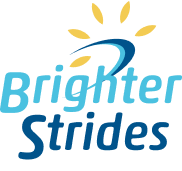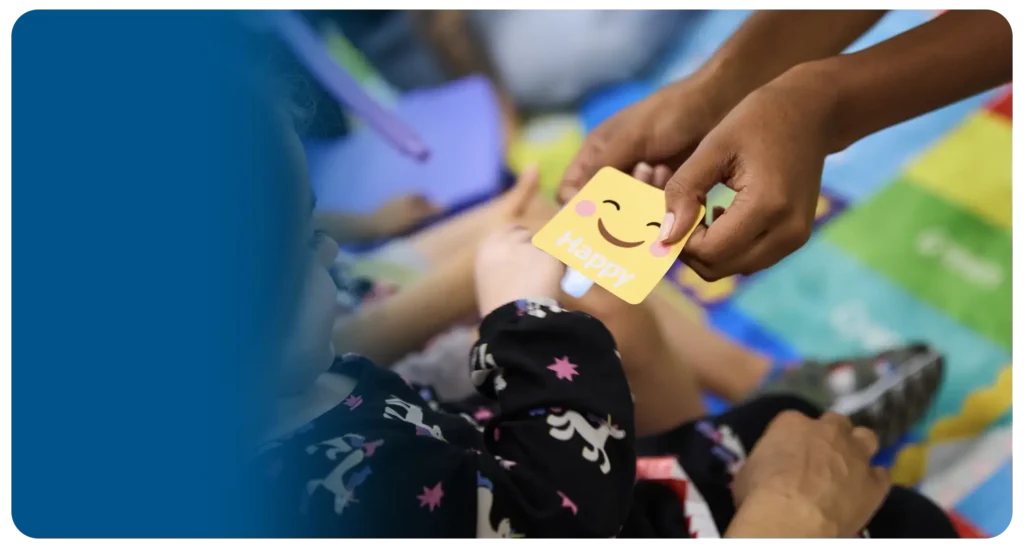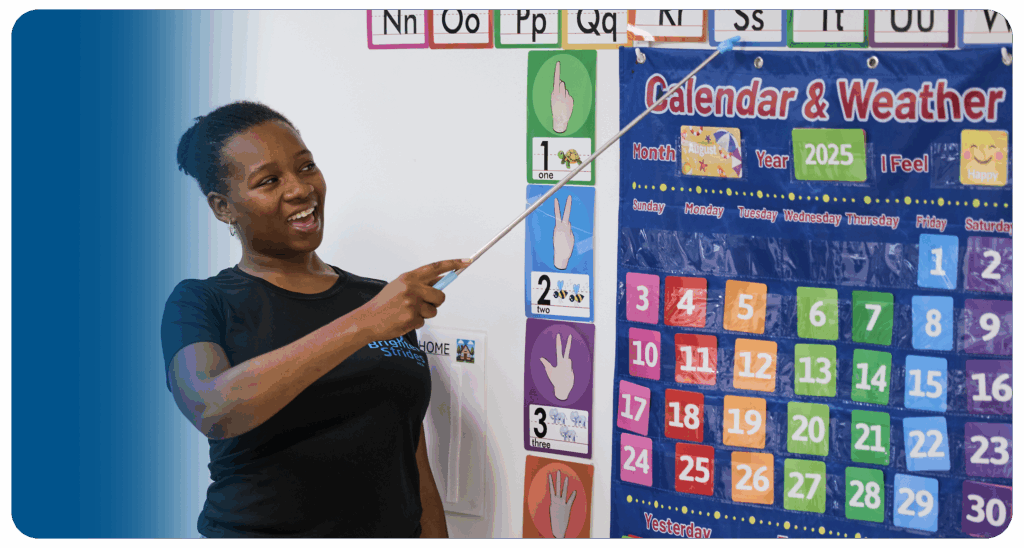Understanding Errorless Learning
In the field of Applied Behavior Analysis (ABA), errorless learning is an instructional approach that focuses on minimizing or even eliminating errors during the learning process. This method involves providing learners with prompts, cues, or assistance to ensure correct responses, maximizing the opportunity for success and skill acquisition.

Concept of Errorless Learning
Errorless learning is based on the principle of prevention rather than correction. It creates a learning environment where mistakes are minimized, and learners consistently experience positive reinforcement for accurate responses. By reducing errors and maximizing correct responses, errorless learning benefits individuals who may struggle with error-prone learning situations.
The main idea behind errorless learning is to set learners up for success from the beginning. This approach involves carefully structuring the learning environment and providing prompts or cues that guide the learner towards the correct response. By doing so, learners are less likely to make mistakes and are more likely to experience success, which can enhance their confidence and motivation to learn.
Benefits of Errorless Learning
Errorless learning in ABA techniques offers various benefits for learners. By minimizing errors and providing immediate prompts and reinforcement, errorless learning promotes success, reduces frustration and anxiety, and facilitates faster learning. This approach is particularly effective for individuals with developmental disabilities, including autism, who may struggle with trial-and-error learning methods.
Research has shown that errorless learning can be more effective than trial-and-error learning for individuals with developmental disabilities. In a study conducted by Dixon et al. (2013), participants who were taught with errorless learning demonstrated significantly better learning outcomes than those who were taught with trial-and-error learning.
By utilizing errorless learning strategies, educators and behavior analysts can create a supportive and positive learning environment for individuals with diverse learning needs. This approach sets the stage for continued growth and skill acquisition, allowing learners to build upon their successes and achieve their full potential.
Implementing Errorless Learning Strategies
To effectively implement errorless learning in Applied Behavior Analysis (ABA) techniques, several strategies can be employed. These strategies create a supportive and structured learning environment that maximizes opportunities for success. Key strategies include individualized instruction, prompting techniques, and reinforcement and feedback.
Individualized Instruction
Individualized instruction is a fundamental aspect of errorless learning in ABA. It involves tailoring the teaching approach to meet the specific needs of each learner. By understanding the unique strengths and challenges of the individual, instructors can design a personalized learning plan that optimizes their learning experience.
This approach includes assessing the learner’s current skills and abilities and developing appropriate teaching materials and activities. By providing instruction at the learner’s level, the chances of errors are minimized, and the learner can experience success more consistently. Individualized instruction also allows for progress tracking and adjustment of teaching strategies as needed.
Prompting Techniques
Prompting techniques are essential in errorless learning to guide individuals towards the correct response. Prompts are cues or hints that provide learners with the necessary information to perform a task or answer a question correctly. Clear and specific prompts help build a foundation of correct responses, increasing the likelihood of successful learning outcomes.
Different types of prompts can be used, such as verbal prompts, gestural prompts, visual prompts, or physical prompts, depending on the learner’s needs and abilities. The use of prompts should be faded gradually to promote independent problem-solving and skill mastery. This process, known as prompt fading, allows learners to generalize their skills to various settings and contexts, enhancing their overall learning experience.
Reinforcement and Feedback
Reinforcement and feedback play a vital role in errorless learning. Positive reinforcement involves providing rewards or praise when the learner responds correctly, reinforcing the desired behavior. This helps to motivate the learner and increase the likelihood of the correct response being repeated.
Feedback is an essential component of errorless learning as it provides information to the learner about the accuracy of their responses. Constructive feedback should be specific, immediate, and focused on the task or behavior. It helps learners understand their strengths and areas for improvement, guiding them towards more accurate responses in the future.
By implementing individualized instruction, utilizing appropriate prompting techniques, and providing reinforcement and feedback, errorless learning in ABA techniques creates an environment where mistakes are minimized, and learners consistently experience positive reinforcement for accurate responses. This supportive approach benefits individuals who may struggle with error-prone learning situations, maximizing their potential for success.
Errorless Learning in ABA Techniques
Errorless learning is a powerful approach utilized in Applied Behavior Analysis (ABA) that aims to promote successful learning experiences by minimizing errors and providing immediate prompts and reinforcement. This technique can be applied to various areas, including language and communication skills, academic skills, and daily living skills in individuals with autism.
Application Areas
Errorless learning in ABA techniques can be applied to multiple areas to facilitate effective skill acquisition and development. Some of the key application areas include:
- Language and Communication Skills: Errorless learning can be utilized to improve language and communication abilities in individuals with autism. By minimizing errors and providing immediate prompts, individuals are guided towards the correct responses, leading to successful learning outcomes.
- Academic Skills: Errorless learning techniques can also be employed to enhance academic skills such as reading, writing, and math. By providing clear prompts and minimizing errors, individuals can build a foundation of correct responses, boosting their confidence and motivation in the learning process.
- Daily Living Skills: Errorless learning can aid in the development of essential daily living skills, such as self-care tasks, cooking, and household chores. By reducing errors and providing immediate prompts, individuals can acquire these skills more effectively and independently.
Success Factors
Errorless learning in ABA techniques promotes success, reduces frustration and anxiety, and facilitates faster learning by minimizing errors and maximizing correct responses. There are several success factors associated with this approach:
- Increased Learning Success: By minimizing errors and providing immediate prompts, errorless learning sets individuals up for success. This approach increases the likelihood of correct responses, leading to a higher rate of successful learning outcomes.
- Boosted Confidence and Motivation: When individuals experience a higher rate of success during the learning process, their confidence and motivation are enhanced. The reduced frustration and anxiety levels associated with errorless learning contribute to a positive learning environment.
- Accelerated Progress: Errorless learning in ABA techniques facilitates faster learning and skill acquisition. By minimizing errors and providing effective prompts, individuals can quickly acquire new skills and build upon their existing knowledge.
- Reduced Frustration and Anxiety: Minimizing errors during the learning process helps to reduce frustration and anxiety levels in individuals with autism. Errorless learning creates a supportive environment where individuals can learn and grow without undue stress.
By implementing errorless learning techniques in ABA, individuals with autism can experience successful learning outcomes, accelerated progress, and increased confidence. This approach fosters a positive learning environment, enabling individuals to acquire essential skills and reach their full potential.
Strategies for Effective Errorless Teaching
When it comes to implementing errorless teaching in ABA (Applied Behavior Analysis), there are key strategies that can enhance the learning experience and promote successful outcomes. Two important strategies for effective errorless teaching include clear prompts and prompt fading techniques.
Clear Prompts
Clear and specific prompts play a fundamental role in errorless teaching in ABA. These prompts guide individuals towards the correct response, minimizing errors and building a foundation of correct responses [4]. By providing clear prompts, learners are more likely to understand what is expected of them and can respond accurately.
In errorless teaching, prompts should be tailored to the individual’s needs and abilities. They should be presented in a way that helps the learner succeed without guessing or making errors. Examples of clear prompts include verbal cues, visual prompts, gesture cues, or physical guidance, depending on the learner’s preferences and learning style.
The goal of clear prompts is to provide the necessary support to ensure correct responses, while gradually fading the prompts over time to promote independence and skill mastery. This transition from prompted responses to independent responses is facilitated through prompt fading techniques.
Prompt Fading Techniques
Prompt fading is a technique used in errorless teaching to gradually reduce the level of assistance provided to learners over time [4]. The purpose of prompt fading is to promote independent problem-solving, generalize skills to various settings and contexts, and enhance the overall learning experience.
There are different prompt fading techniques that can be utilized, such as:
- Least-to-Most Prompt Fading: This technique starts with the most intrusive prompt and gradually fades to less intrusive prompts as the learner demonstrates increased independence. It allows for immediate success and reinforcement while facilitating the development of independent responses.
- Most-to-Least Prompt Fading: In contrast to the least-to-most technique, this approach begins with the least intrusive prompt and gradually increases the level of support if needed. It encourages learners to attempt the task independently before receiving additional assistance.
- Time Delay Prompt Fading: This technique involves introducing a delay between the presentation of the instruction and the prompt. Initially, the delay is minimal, but over time, it is gradually increased. This encourages learners to initiate the correct response without relying on immediate prompts.
Prompt fading techniques should be implemented systematically, with careful consideration of the learner’s progress and individual needs. The gradual reduction of prompts promotes skill generalization, independence, and self-reliance, ultimately leading to more successful learning outcomes.
By employing clear prompts and prompt fading techniques, educators and therapists can create an optimal learning environment that minimizes errors, provides immediate corrective feedback, and fosters a smoother and more efficient learning process for individuals with autism. These strategies help build a strong foundation of correct responses, increasing the likelihood of successful learning outcomes.
Importance of Prompt Fading
Prompt fading is a crucial aspect of errorless learning in Applied Behavior Analysis (ABA), where prompts are gradually reduced to ensure that the learner masters a skill at each level before moving on to the next [5]. This technique plays a vital role in facilitating skill acquisition, promoting independence, and enhancing the overall learning experience of individuals. Let’s explore the importance of prompt fading in the errorless learning process.
Prompt Fading Process
The prompt fading process involves systematically decreasing the level of assistance provided to the learner over time. It aims to transition the learner from relying on external prompts to demonstrating the skill independently. By gradually reducing prompts, learners develop self-reliance, problem-solving abilities, and the capacity to generalize their skills across various settings and contexts.
The process of prompt fading typically follows these steps:
- Full Physical Prompt: Initially, the instructor provides full physical assistance to guide the learner through the skill or task.
- Partial Physical Prompt: As the learner becomes more familiar with the skill, the instructor reduces the level of physical assistance, providing partial guidance.
- Gestural Prompt: The instructor uses gestures, such as pointing or nodding, to prompt the learner.
- Verbal Prompt: Verbal cues or instructions are given to guide the learner through the skill.
- Visual Prompt: Visual cues, such as pictures or written prompts, are used to support the learner.
- Positional Prompt: The instructor changes the position or arrangement of materials to prompt the learner.
- No Prompt: The learner performs the skill independently without any external prompts.
By gradually fading prompts in this manner, learners are able to develop the necessary skills and confidence to perform tasks without constant assistance.
Types of Prompt Fading
Different methods can be used to implement prompt fading strategies. Two common approaches are:
- Least to Most (LTM) Prompt Fading: In this approach, the instructor starts with the least intrusive prompt and gradually increases the level of assistance if needed. The goal is to provide the least amount of support required for the learner to successfully complete the task. This method allows for more independent problem-solving and skill acquisition.
- Most to Least (MTL) Prompt Fading: The MTL approach begins with the most intrusive prompt and then systematically decreases the level of assistance. It provides a higher level of support initially and gradually encourages the learner to rely less on prompts. This method is effective for learners who may need more initial guidance before gaining confidence and independence.
Both LTM and MTL prompt fading methods have their advantages and can be tailored to meet the specific needs and learning styles of individuals in ABA programs.
Prompt fading is an essential component of errorless learning in ABA, as it encourages learners to take ownership of their learning, build independence, and generalize their skills to various situations. By gradually reducing prompts over time, individuals can develop mastery and confidence in their abilities while acquiring new skills.
Comparing Errorless Learning Methods
When it comes to teaching new skills in Applied Behavior Analysis (ABA), two commonly used methods are errorless learning and error correction. While both approaches aim to facilitate learning, they differ in their strategies and outcomes. Let’s explore the differences between errorless learning and error correction, as well as the factors that influence method selection.
Errorless Learning vs. Error Correction
Errorless learning is a proactive teaching method that involves using prompts to prevent students from giving the wrong answer during discrete trials. The goal is to set up materials and prompts in a way that the student is likely to provide the correct answer from the start, increasing the chances of learning. By minimizing errors and maximizing correct responses, errorless learning promotes success, reduces frustration and anxiety, and facilitates faster learning [1].
On the other hand, error correction involves allowing the student to make an error, providing feedback (e.g., saying “no”), and representing the trial [6]. In error correction, the student is given the opportunity to learn from their mistakes and adjust their response. This method traditionally includes a “no-no-prompt” approach where the student can answer incorrectly twice before being prompted on the third trial [6].
Factors Influencing Method Selection
Several factors come into play when deciding whether to use errorless learning or error correction in ABA techniques. These factors include the individual’s learning needs, skill level, and the specific task being taught.
Errorless learning is often preferred when teaching individuals who may struggle with errors, have a history of negative experiences, or are easily frustrated. It provides a more supportive and structured learning environment, reducing the likelihood of errors and allowing for consistent positive reinforcement.
Error correction, on the other hand, may be appropriate when teaching more complex skills or when errors are an essential part of the learning process. It allows individuals to learn from their mistakes, make adjustments, and develop problem-solving skills.
The decision to use errorless learning or error correction may also depend on the desired learning outcomes and the individual’s progress. Some individuals may benefit from a combination of both methods, starting with errorless learning and gradually introducing error correction as their skills improve.
Ultimately, the choice between errorless learning and error correction should be based on the individual’s unique needs and the specific learning objectives. A skilled ABA practitioner will consider these factors and tailor their approach to maximize learning and promote the individual’s success.
By understanding the differences between errorless learning and error correction, as well as the factors influencing method selection, ABA practitioners can make informed decisions when designing intervention plans and teaching new skills.
References
- https://www.abtaba.com/blog/errorless-learning
- https://www.goldenstepsaba.com/resources/errorless-learning
- https://www.goldstarrehab.com/parent-resources/errorless-learning-in-aba
- https://www.apexaba.com/blog/errorless-learning-in-aba
- https://masteraba.com/errorless-learning/
- https://autismclassroomresources.com/what-do-i-do-about-errors-in-discrete-trials-the-errorless-learning-v-error-correction-conundrum/





